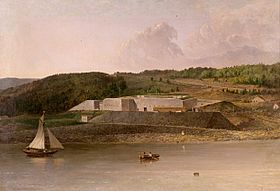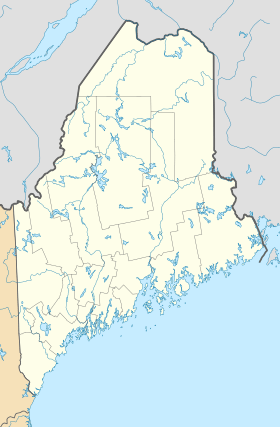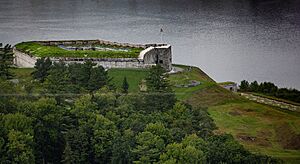Fort Knox (Maine) facts for kids
|
Fort Knox
|
|

Fort Knox, Maine painting by Seth Eastman done between 1870 and 1875
|
|
| Location | Prospect, Maine |
|---|---|
| Area | 124 acres (50 ha) |
| Built | 1844 |
| Architect | Colonel Joseph G. Totten, US Army Corps of Engineers |
| NRHP reference No. | 69000023 |
Quick facts for kids Significant dates |
|
| Added to NRHP | October 1, 1969 |
| Designated NHL | December 30, 1970 |
Fort Knox is a historic fort in Prospect, Maine. Today, it is known as Fort Knox State Park or Fort Knox State Historic Site. You can find it on the western bank of the Penobscot River, about 5 miles (8 km) from where the river meets the ocean.
This fort was built between 1844 and 1869. It was the first fort in Maine made entirely of granite. Most older forts used wood, earth, and stone. The fort is named after Major General Henry Knox. He was the first U.S. Secretary of War and led the artillery during the American Revolutionary War.
Fort Knox is a great example of a mid-19th-century granite fort built to protect the coast. Because it is so well-preserved, it was added to the National Register of Historic Places in 1969. It was also named a National Historic Landmark in 1970. Today, Fort Knox is also the entrance to the observation tower of the Penobscot Narrows Bridge, which opened in 2007.
Contents
Why Fort Knox Was Built
Protecting Maine's Coastline
People in Maine remembered difficult times during past wars. During the American Revolution, a British attack in 1779, called the Penobscot Expedition, was a big loss for the Americans. They lost many ships and soldiers.
Later, in 1814, during the War of 1812, British ships and soldiers sailed up the Penobscot River. They defeated American forces in the Battle of Hampden. After their victory, the British looted towns like Hampden and Bangor. These defeats made people in Maine feel unprotected by Massachusetts, which governed Maine at the time. This feeling helped Maine become its own state in 1820.
Concerns About Future Attacks
Years later, from 1838 to 1839, the Aroostook War caused more worries about British attacks. People were concerned that the region could be attacked again, just like in 1814. The Penobscot valley and Bangor were also important for getting wood to build ships.
To protect this vital area, the government decided to build a strong fort. Fort Knox was planned as a large, expensive granite fort at the mouth of the Penobscot River. It was part of a system of coastal defenses for the United States.
Building Fort Knox
Construction Details
Work on Fort Knox began in 1844. It continued until 1869, when funding for masonry forts stopped. The fort was mostly finished, but some parts on the roof, called the barbette level, were not completed. Money from Congress came and went, so the fort's full design was never completely built. Even so, over $1,000,000 was spent on it.
The granite used for the fort came from Mount Waldo in Frankfort, about 5 miles (8 km) upriver. The main design for the fort was created by Joseph G. Totten. He was a leading engineer for the United States Army Corps of Engineers at that time.
Special Features of the Fort
Besides the main fort, which was designed for 64 guns, there were two open batteries facing the river. These batteries had special "shot furnaces." These furnaces could heat cannonballs until they were red-hot. The idea was that a hot cannonball could set wooden enemy ships on fire if it hit them. However, these furnaces became outdated when ironclad warships (ships made of metal) were invented.
Fort Knox During Wars
The American Civil War
Fort Knox never actually saw battle, but it was staffed during wartime. During the American Civil War, volunteers from Maine helped man the fort. These were mostly new recruits training before they went to active duty. Engineers also worked to update the fort's defenses. They adapted the batteries to use the new Rodman cannon.
The Spanish–American War
During the Spanish–American War, a group of soldiers from Connecticut was stationed at Fort Knox. A special plaque at the fort tells about a "controlled minefield" that was placed in the river. This was a system of underwater explosives designed to protect the harbor. Congress provided $3,200 for this defense shortly after the war began.
After the Wars
After the Spanish–American War, only one person, called the "Keeper of the Fort," stayed to look after it. This caretaker was responsible for maintaining the fort and reported to Fort Preble in South Portland. In 1900, a permanent "torpedo storehouse" was built at the fort. This building was used to store naval mines, which were called torpedoes back then. Today, this building is the Visitor Center.
In 1923, the federal government decided the fort was no longer needed. They put its 125 acres (51 ha) up for sale. The state of Maine bought it for $2,121. Since 1943, it has been managed as a Maine state historic site.
Fort Knox Today
Today, Fort Knox is known as one of the best-preserved and most accessible forts in the United States. Almost all of the fort is open for people to explore. You can see several old weapons on display. These include two large 15-inch Rodman smoothbore cannons in the water batteries. One of these has been remounted, which is rare because they weigh 50,000 pounds (22,680 kg)! They were the biggest guns made during the Civil War era.
You can also see an 8-inch Rodman converted rifle near the parking lot. Inside the fort, there is a 10-inch Rodman smoothbore cannon. There are also several 24-pounder flank howitzers. Some of these howitzers are on their original carriages, which have "Fort Monroe 1862" stamped on their bronze plates.
Friends of Fort Knox
The Friends of Fort Knox is a non-profit group formed in the 1990s. This group has done a lot to repair and improve the fort. They helped turn the old Torpedo Storage Shed into the Visitor and Education Center. They also restored the Officer's Quarters and added helpful signs.
The Friends group also repaired a powder magazine and restored four 24-pound flank defense howitzers. They fixed and opened the enlisted men's quarters, cistern, and other rooms. They have also done extensive masonry repair work on the fort.
In 2012, the Friends group made an agreement with the State Department of Conservation. They took over the daily operations of the fort. The State still owns the fort, but the Friends are responsible for all maintenance of the grounds and buildings. They can also make improvements as long as they follow the law.
Since 2012, the Friends have been allowed to set the entrance fee for the fort. They need approval from the Bureau of Parks and Lands. The goal is to keep entry affordable for Maine residents. The Friends keep 85 percent of the entrance fee money, and the rest goes to the State General Fund.
Fort Knox in Media
Television Shows
Fort Knox has been featured on television shows about paranormal activity. It appeared on the Travel Channel series Most Terrifying Places in America in 2018. The episode was called "Cursed Towns."
The Travel Channel's show Destination Fear also filmed at the fort. This was for the third episode of their third season, which aired in 2021.
Images for kids
-
View of Bucksport
-
View from Bucksport, Maine waterfront
-
Shot furnace, southern water battery
See Also


















